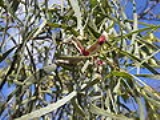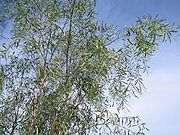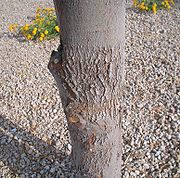
Acacia salicina
Encyclopedia
Acacia salicina is a thornless species of Acacia
tree native to Australia
.
Common names include Cooba, Native Willow, Willow Wattle, Broughton Willow,Sally Wattle and Black Wattle.
It is a large shrub
or small evergreen tree
growing 3 to 20 m tall. It has a life span of about 10–15 years. In the Northern Hemisphere
, Acacia salicina flowers primarily from October to January and the seed pods are often visible from April to July. The tree's seeds are shiny, black and have a crimson appendage-like aril
.
Acacia salicina is "closely related" to Acacia ligulata and Acacia bievenosa.
for livestock during dry periods, since the tree can withstand drought quite well. Its foliage and pods compare quite poorly to other fodders with regard to digestibility by livestock
. This affects its available nutritional value.
 A. salicina is excellent for landscaping
A. salicina is excellent for landscaping
in dry areas.
 The wood is very hard and it is used in making fine furniture
The wood is very hard and it is used in making fine furniture
. At one time, the tree's wood was used in the manufacture of axle
s for wagon wheels.
Acacia salicina's wood burns nicely and makes good fuel. Its calorific content is 18900kJ/kg dry mass. The tree produces seed and timber for woodworking in as little as five years after planting.
as a toxin
for fishing
. The leaves of A. salicina are thought to be psychoactive, since indigenous Australians "burn its leaves and smoke the ash to obtain a state of inebriation."
Acacia
Acacia is a genus of shrubs and trees belonging to the subfamily Mimosoideae of the family Fabaceae, first described in Africa by the Swedish botanist Carl Linnaeus in 1773. Many non-Australian species tend to be thorny, whereas the majority of Australian acacias are not...
tree native to Australia
Australia
Australia , officially the Commonwealth of Australia, is a country in the Southern Hemisphere comprising the mainland of the Australian continent, the island of Tasmania, and numerous smaller islands in the Indian and Pacific Oceans. It is the world's sixth-largest country by total area...
.
Common names include Cooba, Native Willow, Willow Wattle, Broughton Willow,Sally Wattle and Black Wattle.
It is a large shrub
Shrub
A shrub or bush is distinguished from a tree by its multiple stems and shorter height, usually under 5–6 m tall. A large number of plants may become either shrubs or trees, depending on the growing conditions they experience...
or small evergreen tree
Tree
A tree is a perennial woody plant. It is most often defined as a woody plant that has many secondary branches supported clear of the ground on a single main stem or trunk with clear apical dominance. A minimum height specification at maturity is cited by some authors, varying from 3 m to...
growing 3 to 20 m tall. It has a life span of about 10–15 years. In the Northern Hemisphere
Northern Hemisphere
The Northern Hemisphere is the half of a planet that is north of its equator—the word hemisphere literally means “half sphere”. It is also that half of the celestial sphere north of the celestial equator...
, Acacia salicina flowers primarily from October to January and the seed pods are often visible from April to July. The tree's seeds are shiny, black and have a crimson appendage-like aril
Aril
An aril is any specialized outgrowth from the funiculus that covers or is attached to the seed. It is sometimes applied to any appendage or thickening of the seed coat in flowering plants, such as the edible parts of the mangosteen and pomegranate fruit, the mace of the nutmeg seed, or the...
.
Acacia salicina is "closely related" to Acacia ligulata and Acacia bievenosa.
Wood
- (-)-7,8,3',4'-tetrahydroxyflavanone
- 7,8,3',4'-tetrahydroxydihydroflavonol
- 7,8,3',4'-tetrahydroxyflavonol
Natural growing conditions
A. salicina is found parts of Eastern Australia. The average yearly precipitation over the entire range is 375-550mm, with the plant itself found growing in regions receiving in excess of 1500mm annually in northern Queensland and as low as 100mm annuall in central Australia. Its natural altitude range is from 50-300m above sea level. It does well in full sun exposure and it tolerates frosts down to -6.7 deg. C (-20 deg. F).Fodder
The tree's foliage and seed pods are important fodderFodder
Fodder or animal feed is any agricultural foodstuff used specifically to feed domesticated livestock such as cattle, goats, sheep, horses, chickens and pigs. Most animal feed is from plants but some is of animal origin...
for livestock during dry periods, since the tree can withstand drought quite well. Its foliage and pods compare quite poorly to other fodders with regard to digestibility by livestock
Livestock
Livestock refers to one or more domesticated animals raised in an agricultural setting to produce commodities such as food, fiber and labor. The term "livestock" as used in this article does not include poultry or farmed fish; however the inclusion of these, especially poultry, within the meaning...
. This affects its available nutritional value.
Landscaping

Landscaping
Landscaping refers to any activity that modifies the visible features of an area of land, including:# living elements, such as flora or fauna; or what is commonly referred to as gardening, the art and craft of growing plants with a goal of creating a beautiful environment within the landscape.#...
in dry areas.
Wood

Furniture
Furniture is the mass noun for the movable objects intended to support various human activities such as seating and sleeping in beds, to hold objects at a convenient height for work using horizontal surfaces above the ground, or to store things...
. At one time, the tree's wood was used in the manufacture of axle
Axle
An axle is a central shaft for a rotating wheel or gear. On wheeled vehicles, the axle may be fixed to the wheels, rotating with them, or fixed to its surroundings, with the wheels rotating around the axle. In the former case, bearings or bushings are provided at the mounting points where the axle...
s for wagon wheels.
Acacia salicina's wood burns nicely and makes good fuel. Its calorific content is 18900kJ/kg dry mass. The tree produces seed and timber for woodworking in as little as five years after planting.
Other uses
The bark has been traditionally put to use by Indigenous AustraliansIndigenous Australians
Indigenous Australians are the original inhabitants of the Australian continent and nearby islands. The Aboriginal Indigenous Australians migrated from the Indian continent around 75,000 to 100,000 years ago....
as a toxin
Toxin
A toxin is a poisonous substance produced within living cells or organisms; man-made substances created by artificial processes are thus excluded...
for fishing
Fishing
Fishing is the activity of trying to catch wild fish. Fish are normally caught in the wild. Techniques for catching fish include hand gathering, spearing, netting, angling and trapping....
. The leaves of A. salicina are thought to be psychoactive, since indigenous Australians "burn its leaves and smoke the ash to obtain a state of inebriation."

